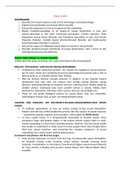Summary
3.5 Eating, sex and other needs, Problem 2 (Sex) summary
- Course
- Institution
Elaborate notes for Problem 2 (Sex) from course 3.5 Eating, sex, and other needs. DSM-5 criteria included. Also part of a bigger summary including all 4 problems.
[Show more]



